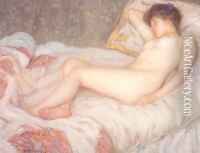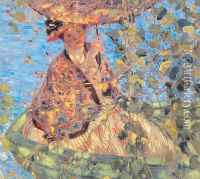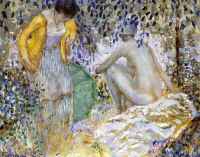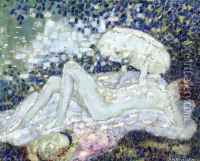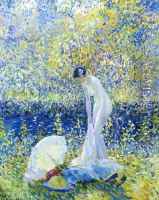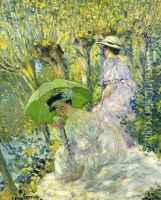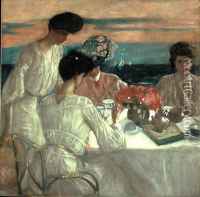Frederick Carl Frieseke Paintings
Frederick Carl Frieseke was an American Impressionist painter known for his vibrant depictions of landscapes, domestic scenes, and particularly for his portrayal of the effects of dappled light on the skin of female figures. He was born on April 7, 1874, in Owosso, Michigan, and showed an early interest in art. Frieseke studied at the Art Institute of Chicago and later at the Académie Julian in Paris under Benjamin Constant and Jean-Paul Laurens. His time in France exposed him to the works of the Impressionists, which would have a profound influence on his style.
Frieseke's career took off when he settled in the artists' colony of Giverny, where Claude Monet lived and worked. There, Frieseke fully embraced the Impressionist technique of painting en plein air (outdoors) and began to experiment with the interplay of light and color, which became a hallmark of his work. His paintings from this period often feature women in sun-dappled gardens or interiors filled with floral arrangements, conveying a sense of leisure and sensuality.
Throughout his career, Frieseke exhibited his work widely and received numerous awards, including a gold medal at the 1915 Panama-Pacific International Exposition. Despite his success, he never sought the limelight and preferred a quiet life devoted to painting. After World War I, Frieseke's style began to shift away from pure Impressionism towards a more structured approach, though he continued to focus on the female figure and domestic scenes.
Frieseke's health began to decline in the 1930s, and he moved to Normandy, where he passed away on August 24, 1939. His works are held in major collections around the world, including the Metropolitan Museum of Art in New York and the Art Institute of Chicago. Frieseke's contribution to American Impressionism remains significant, as he bridged European techniques with American sensibilities, creating a body of work that is celebrated for its beauty, technical skill, and evocative use of light.

